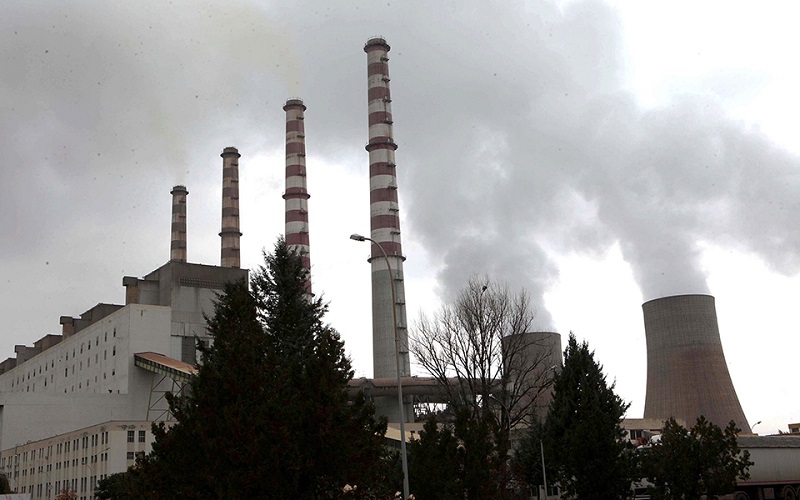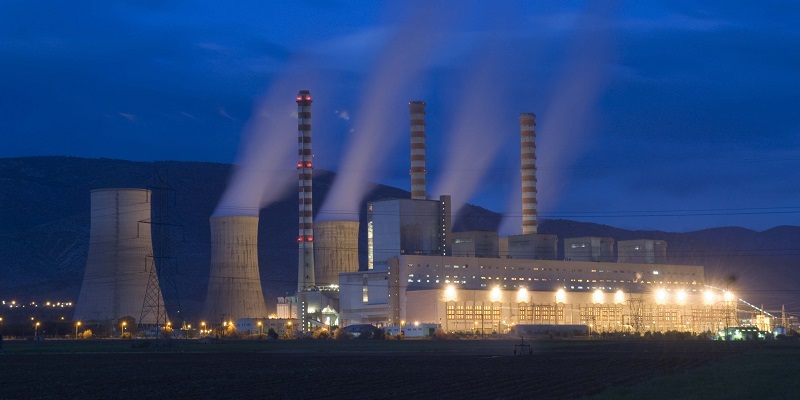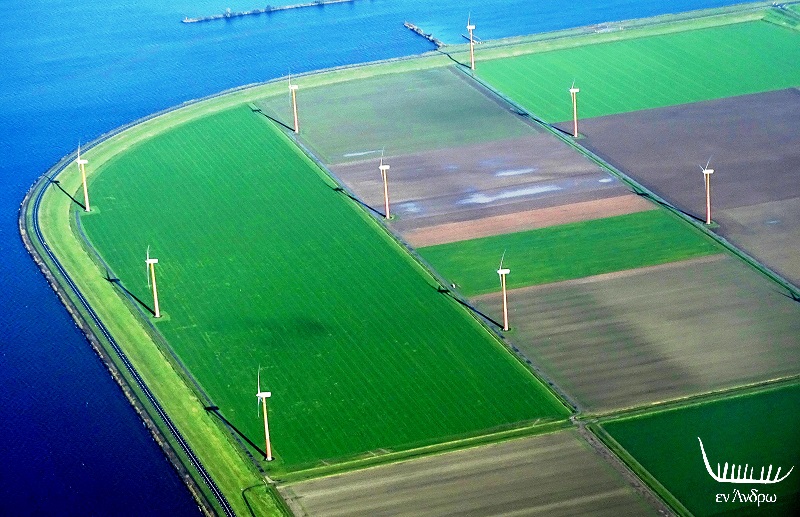Θάνατοι πουλιών και ανεμογεννήτριες: Τι λένε οι έρευνες...

Λιγνιτικό εργοστάσιο παραγωγής ρεύματος στην Κοζάνη.
(Ο καθηγητής Λ. Τσικριτζής, της οικολογικής κίνησης Κοζάνης και του ΤΕΙ Κοζάνης μας γράφει για τις αιτίες θανάτου των πουλιών με βάση διεθνείς έρευνες και δείχνει πως εκτός από την καταστροφή του περιβάλλοντος τα ορυκτά καύσιμα και άλλες ανθρωπογενείς αιτίες σκοτώνουν εκατομμύρια πουλιά ετησίως. Με βάση τα στοιχεία των ερευνών που παραθέτει τα πουλιά κινδυνεύουν σχετικά ελάχιστα από τις ανεμογεννήτριες και πολύ περισσότερο από πολλές άλλες αιτίες. Δημοσιεύοντας τα κείμενα αυτά δεν προτείνουμε φυσικά να μπουν ανεξέλεγκτα ανεμογεννήτριες στην Άνδρο. Προτείνουμε, απλώς, ο Καμπανός και το Στενό να δεχθούν έναν περιορισμένο αριθμό Α/Γ βοηθώντας την εθνική οικονομία, το περιβάλλον, αλλά και την Άνδρο, όπως έδειξαν οι συνεισφορές των δύο εταιρειών που ξεκίνησαν να δραστηριοποιούνται στα άκρα του νησιού - ΕΝ ΑΝΔΡΩ)
Καλημέρα φίλοι του ΕΝ ΑΝΔΡΩ,
Σας στέλνω από την οικολογική κίνηση Κοζάνης ένα link και ένα σχετικό κείμενο-περίληψη του υπουργείου Περιβάλλοντος του Καναδά προς ενημέρωση όσων ασχολούνται με την οικολογία και ενδιαφέρονται και για τα πουλιά στην Άνδρο. Δεν θέλουμε να υποδείξουμε σε κανέναν το πόσες ή αν πρέπει να μπουν ανεμογεννήτριες σε έναν τόπο. Το πόσες και το αν το καθορίζει ο εθνικός και ο περιφερειακός σχεδιασμός. Όμως το αν χρειάζονται κι αν βοηθούν τα πουλιά το λένε οι έρευνες περιβάλλοντος και οι έρευνες που αναφέρονται στην κλιματική αλλαγή και στα πουλιά. Διαβάστε τα στοιχεία και θα καταλάβετε…
Χαιρετισμούς από την Κοζάνη στον δήμαρχο Άνδρου που υπήρξε φοιτητής μου.
Λάζαρος Τσικριτζής, καθηγητής ΤΕΙ Κοζάνης
1. Αιτίες θανάτου πουλιών

Το Υπ. Περιβάλλοντος του Καναδά δημοσίευσε αναλυτική μελέτη για τις βασικές αιτίες θανάτου πουλιών στη χώρα.
https://www.documentcloud.org/documents/800519-environment-canada-bird-study.html
Προφανώς τα συγκεντρωτικά στοιχεία για τους θανάτους πουλιών δεν είναι πάντα ιδιαίτερα επεξηγηματικά, αλλά έχουν πάντα ενδιαφέρον:
- Στις πρώτες θέσεις θανάτων πουλιών είναι τα κτίρια και οι γραμμές μεταφοράς ενέργειας (25 εκατομμύρια η κάθε αιτία).
- Στην ένατη και τελευταία θέση της λίστας βρίσκονται οι κεραίες επικοινωνιών με 220 χιλιάδες θανάτους.
- Τέλος οι θάνατοι από ανεμογεννήτριες είναι πολύ λιγότεροι, και φτάνουν στις 16,7 χιλιάδες πουλιών ετησίως. Οι ανεμογεννήτριες προκαλούν έναν αριθμό θανάτων στα πουλιά (0,269 άτομα /GWh), αλλά οι ανθρακικές μονάδες εξολοθρεύουν 20 φορές περισσότερα (5,18/GWh).
ΣΗΜΕΙΩΣΗ: Δεν έχουν υπολογιστεί οι θάνατοι πουλιών λόγω της κλιματικής καταστροφής που προκαλείται κυρίως από τα ορυκτά καύσιμα. Σε άλλες έρευνες όμως (παρακάτω) υπάρχουν και τέτοιες συγκρίσεις.

2. ΑΠΕ και ΟΡΥΚΤΑ ΚΑΥΣΙΜΑ: Συγκρίσεις για τους θανάτους πουλιών...
http://reneweconomy.com.au/2012/want-to-save-70-million-birds-a-year-build-more-wind-farms-18274
Want to save 70 million birds a year? Build more wind farms
By Mike Barnard on 10 August 2012

Wind turbines are often criticised for killing birds. Fights against siting wind turbines in bird migration corridors or in bird habitat are frequent. Highly inflammatory language is used by anti-wind lobbyists such as ‘bird mincer’, ‘bird blender’ and ‘eagle killers’. Outlandish numbers of deaths are often attributed to them.
If this were true, it would be a matter for great concern and a reason to stop constructing wind farms. If humans weren’t killing birds by the hundreds of millions through habitat destruction and other human impacts that weren’t mitigated by wind farms, this would be a big problem. Even if the impact were in the same order of magnitude as other impacts, this would be a reason to slow wind farm construction.
However, replacing all fossil fuel generation with wind turbines world-wide would save roughly 70 MILLION birds’ lives annually. Wind energy is actually the form of generation with the lowest impact on wildlife. Wind farms kill less than 0.0001 per cent of birds killed by human actions annually, and perhaps 0.00000075 per cent of birds on the planet annually.
Wind farms are a strong net benefit for bird populations, and their direct impacts on bird populations are so insignificant that they can’t be considered a problem compared to the advantages.
Every other form of generation has at some point in its lifecycle the possibility of:
– Large scale, population-level mortality and/or habitat destruction causing population(s) decline and/or reduced biodiversity;
– A threat to species survival regionally;
– Biologically significant mortality or reduction in endangered or threatened species;
or
– Limited, but locally to regionally important mortality and/or habitat destruction, with limited population-level effects;
– Any biodiversity declines would be local to regional only;
– No threat to species survival, but demonstrated effects to physiology and/or behavior of exposed individuals;
– Incidental mortality and/or incidental habitat destruction of endangered or threatened species;
Wind energy at worst has only the possibility of:
– Limited and local mortality and/or habitat destruction, with no population- level effects;
– Biodiversity declines are unlikely;
– Endangered or threatened species may be exposed, but mortality unlikely.
This is according to the most recent of two multi-energy source studies of wildlife mortality, Comparison Of Reported Effects And Risks To Vertebrate Wildlife From Six Electricity Generation Types In The New York/New England Region, prepared for the New York State Energy Research And Development Authority in 2009.
Fossil fuel generation kills 17 time more birds per gigawatt-hour than wind energy
It is also worth considering the alternative: more fossil fuel generation. An energy governance study done in Singapore compared fatalities across forms of electrical generation in 2009 and published its results. Wind farms and nuclear power stations are responsible each for between 0.3 and 0.4 fatalities per gigawatt-hour (GWh) of electricity while fossil-fueled power stations are responsible for about 5.2 fatalities per GWh. (Coincidentally, human fatalities per TWh of electricity are roughly 0.4 for nuclear and wind, and roughly 5 for coal according to one study; the very similar ratios between human and avian mortality are striking).
This graph of estimated world-wide avian mortalities in 2006 from the energy policy report that established relative bird deaths for nuclear, wind and fossil fuel is telling:
According to Worldwide electricity production from renewable energy sources, 2011 Edition, fossil fuels generated 14,264.4TWh of electricity in 2010. Assuming this number and the ratio of mortality, replacing all fossil fuel generation with wind energy would save the lives of roughly 70 MILLION BIRDS ANNUALLY.
Human causes kill up to 1.5% of birds annually; wind farms kill 0.00000075%
Birds are killed as a result of human impacts in large numbers every year. Per Sibley Guides, the biggest human-related causes of deaths annually are:
– Lighted window impacts: 97 to 976 million
– Predatory house cats: 500 million or more
– High-tension wire impacts: up to 174 million or more
– Pesticides: 72 million and possibly many more
– Car impacts: 60 million
Even these very large numbers are relatively small compared to the threat of habitat loss from acid rain from burning coal, open-pit mining for coal, mountain-top removal mining for coal and pollution.
These numbers are still very small compared to the 100-200 billion birds on the planet. Adding all of the anthropogenic-impact causes of death above together might see 1.5 billion bird deaths, or 0.75 per cent to 1.5 per cent of the total. Unfortunate, but not species threatening except in very specific circumstances.
Wind turbines have been added to the list of bird killers in recent years. This is not because they kill significant numbers of birds; the worst cases have a handful of birds per turbine per year. According to the best impartial sources, they kill perhaps 20,000 – 33,000 birds annually in the USA. As the US has roughly 20 per cent of the wind generation capacity in the world, assuming 150,000 bird deaths world-wide isn’t unreasonable. Of course, numbers of wind turbines are increasing, but so is siting sensitivity and mitigations (more below). Compared to the roughly 1.5 billion from other sources, this cannot be considered significant. Even 10 times the the number of mortalities – which one anti-wind organisation, the American Bird Conservancy, claims – still makes wind turbines a very small contributor to avian fatalities.
It’s also worth noting that while some wind farms kill a few birds per wind turbine per year, many wind farms kill almost no birds or actually no birds per year.
“However, there has been a noticeable absence or low frequency of avian deaths at other wind farms. Kerlinger (1997) conducted a five-month survey at the Searsburg, Vermont Wind Energy Facility and found no fatalities. Lubbers (1988) surveyed eighteen 300kW wind turbines in Oosterbierum, Denmark, and found only 3 fatalities over 75 days, or less than 0.8 per turbine per year. Marsh (2007) found a bird casualty rate of 0.22 birds per turbine year after monitoring 964 turbines across 26 wind farms in Northern Spain. Rigorous observation of a 22-turbine wind farm in Wales documented that it has killed no birds, and researchers found a shift in bird activity to a neighboring area (Lowther, 1998).”
Wind turbines have tended to kill larger birds such as raptors and vultures in slightly higher numbers. This is important as there are generally fewer of the larger birds and in the case of raptors they are an apex predator. Threatening populations of these birds has been a concern, especially in the Altamont Pass, which is a raptor migration route. However, bird deaths per turbine have dropped off their in recent years with the elimination of older, lattice-tower turbines that were used as roosts by raptors. Attention to siting in larger bird migration routes is reasonable, as is attention to habitant for species in threat of extinction.
And a recent UK study on 10 bird species near wind turbines found that construction disrupted populations slightly, but that operation did not cause any challenges for the majority of species, aided one species and only had a minor negative impact on numbers of one type of bird. In general, song birds migrate at 2000-4000 feet, well above the level of wind turbines. Sea birds have been shown to avoid wind turbines based on radar and thermal imaging studies; the study found that millions of sea birds migrated past an offshore wind farm annually, and only two were killed.
The wind industry continues to reduce its impact on birds
Despite the comparative benefits wind farms and the low impacts, the wind industry and researchers continue to research ways to reduce impacts on wildlife further. Promising approaching outside of siting sensitivity include radar assessment of bird density causing wind farm feathering, painting the blades purpleto avoid attracting birds during the day and avoiding steady white lights that attract insects and birds at night.
Mike Barnard has been a deeply interested observer of energy systems for three decades. Following a lengthy discussion with Margaret Atwood and others related to siting of wind turbines in a major birding area on her blog, he became a blogger on energy concerns, focusing on debunking myths about wind energy. As a day job, Mike has had the good fortune to work on Smart Grid projects for IBM’s clients, in addition to many other interesting initiatives that IBM is uniquely positioned to undertake. More of Mike’s material on wind energy can be found at http://www.quora.com/Mike-Barnard/answers/Wind-Power. He tweets only the most interesting things he runs across at @mbarnardca.



